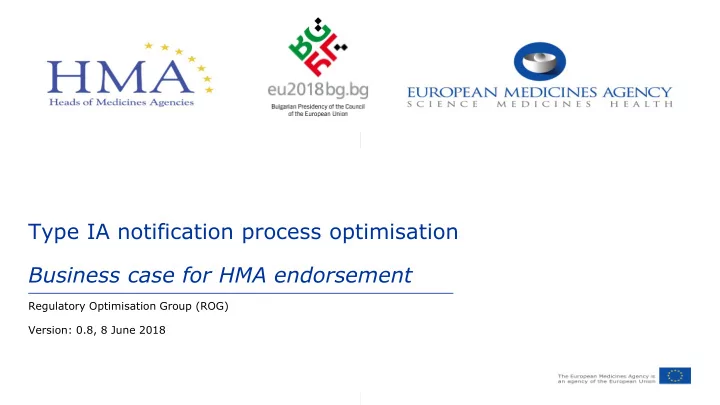

Type IA notification process optimisation Business case for HMA endorsement Regulatory Optimisation Group (ROG) Version: 0.8, 8 June 2018
ROG stakeholder engagement in business cases HMA (+ EMA MB) Endorse Inform ROG business case development Final draft HMA endorsement Implementation Initiate Develop Hand over Identify Consult Inform Liaise Inform Stakeholders/ responsible working groups
Context of Type IA business case Type IA variation (art. 2.2 of regulation 1234/2008): ‘minor variation of Type IA’ • means a variation which has only a minimal impact, or no impact at all, on the quality, safety or efficacy of the medicinal product concerned. High volume, low impact (do and tell) • Reduce administrative burden, optimise and simplify processes within the network, • achievable short term gains. + Overproduction Overprocessing Waste of talent Solution: lowering Solution: reducing Gain: time for value the volume time spent adding activities
ROG recommendations for the Type IA business case Simpler Review Review of classification process scopes scopes with aim to Remove duplication of checks simplification of the and automate the process Classification Guideline e.g. using IT as enabler (e.g. SPOR) part of the CEP updates (where no additional information is included on a CEP) Simplify submissions by: • Replacing the cover letter with an electronic delivery file Variations Classification • Including the copy of the Guideline to be amended to Guideline and other confirmation allow reporting via databases checks into the eAF • Use SPOR to remove duplication of checks
Type IA variations optimisation roadmap Long term vision that will be delivered incrementally as IT solutions (existing and new) become available and the Variations Classification Guideline is revisited.
Industry support • Industry’s full support to ROG’s proposals stimulating more efficient way of handling variations • Variations’ optimisation process shall not undermine financial stability of the regulators • Regulators to monitor costs’ allocation related to variations for an appropriate financing model - Future discussion and agreement between interested parties
Solutions for HMA endorsement In order to start the optimisation of the Type IA variation process, the HMA is requested to endorse that the ROG will engage with the responsible stakeholders for the following projects: a. Replace cover letter and dispatch list with CESP delivery file (responsible: CMDx + CESP group ) b. Include the checklist with specified conditions / documentation requirements (from the Variations Classification Guideline) in the eAF (responsible: CMDx + eAF MG ) c. Replace specific CEP updates that do not contain additional new information on the CEP by referring to the current version (responsible: CMDx , ongoing project) d. Facilitate the submission of a new sPSMF in case of MAH transfers by using the delivery file of the CESP (human only, responsible: CMDh + CESP group ) e. Inclusion of manufacturer’s data + role in the first version of the Product part of the SPOR database (responsible: EMA ) Note: for solution C (and possibly D), a change in the guideline (human) is required (responsible: EC ). This is already proposed in the new legislation for veterinary medicinal products.
Conditions for further optimisation of Type IA variations To work on further optimisation of the Type IA variation process, some conditions needs to be fulfilled in the near future: Using SPOR Product database and the Target Operating Module for PMS to automate some Type IA • changes in the future requires organisation information from OMS to be included in PMS iteration 1 . Implementing electronic Product Information (ePI) in a structured format instead of the currently • used MS Word and PDF files, exchange of information could be done in a more efficient way and it would provide a step towards possibilities to automise some steps in Type IA variations that affect also the SmPC, PL or labelling. To change the way we process some of the Type IA variations into for example using database • exchange of information, an update of the variation classification guideline is needed. A good opportunity for this, if not earlier, would be when an update is needed to meet the new requirements in the upcoming new veterinary legislation. 8
Recommend
More recommend